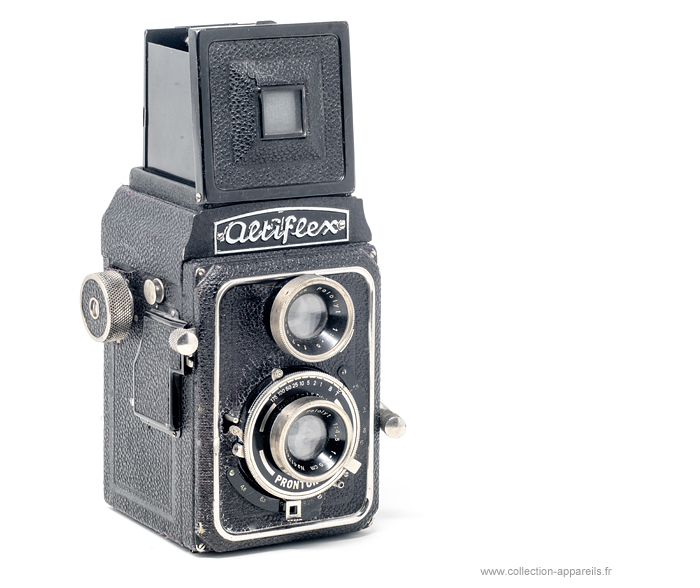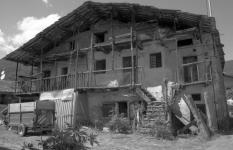|
Eho Altissa Altiflex II |

Manufactured or assembled in Germany from 1938 to (Circa) 1949.
Index of rarity in France: Rare (among non-specialized garage sales)
Inventory number: 14727
See the complete technical specifications
Chronology of cameras Eho Altissa
The Altiflex cameras are Twin-Lens Reflex (TLR) cameras delivered between 1937 and 1949 by Eho-Altissa from Dresden in Germany. They are relatively simple cameras that can have a wide range of variants, in particular in terms of the shutter/lens combinations.
There was a structural evolution in the short life span of the camera, in terms of several features such as the back attachment, back lock, and body release, which is evident in both models I and II. As in other period cameras, the diagnostic characteristics of the main models are not entirely consistent, as some features were not introduced simultaneously. Thus, one can find examples that share mixed features between models I and II. Both models I and II were supplied with a diversity of shutter/lens combinations, and together with the evolution of the features, numerous variants occur.
This led to several idiosyncratic classifications, such as the one from Michael Spehr’s Altissa-Museum site (now extinct), which several sources still follow. Another source is the models’ references by W. Kirkmann (Deutsche Kameras 1900-1945) extracted from adverts that have a more source-supported basis but do not reflect factory designations. McKeown (2005-6) has a more simplistic approach and only separates the main models without further compartmentation.
Altiflex (Trojan)
The first model, simply ‘Atiflex’ or ‘Altiflex Trojan’ was delivered in 1937 (but some adverts appeared in 1936) and is characterized by the particular nameplate with the name written in capitals. The back, including the sides, detaches completely with side metal locks, and the red window is positioned on the bottom. Film advance knob in plastic. The name Trojan could be embossed on the back leather.
Altiflex I
This model was also delivered in 1937 and introduced the nameplate in the script. The back can be fully detached (lateral locks in plastic) or hinged (lock on the top of the back), and the red window is now positioned on the back with a sliding cover. The film advance knob can be plastic or metal. The shutter release is on the right side of the body, but there are examples without it. It has a wider range of shutter /lens combinations, and generally, there is an Eho logo on the hood.
Altiflex II
This model was delivered in 1938 and has a built-in sports finder and generally a double exposure prevention mechanism on the side of the body. The back is hinged with the top lock mechanism, and the release is always on the body. Film advance knob in metal.
Both models I and II could be made with an extinction meter.
The Altiflex cameras were rebranded in 1938 by Birnbaum (Rumbuck, Czechoslovakia) as Embirflex (Altiflex I) and Super Embirflex (Altiflex II). At the same time Wirgin (Wiesbaden, Germany) made an export version of the Altiflex (now called the Wirgin Reflex), including the variants with extinction meter.
This camera is an Altiflex II with an articulated back and top lock, a double exposure prevention mechanism on the side of the body, and a sports finder. The lens/shutter combination has a Laack Pololyt f4.5 on a Gauthier Prontor II central shutter. As for all model II, the advance knob is metal, and the release is on the body, acting directly on the double exposure prevention mechanism.

Eho Altissa Altiflex II with Prontor II shutter and Laack Pololyt f4.5
Short history EHO Altissa written according to the information present on the site: www.altissa-museum.de
Foundation in April 1904 of Photographische Manufaktur Engineer Richard Knoll
In March 1926, taken of charge by Emil Hofert
The July 4, 1927, the company becomes Fabrik photographischer Artikel Emil Hofert vorm. Richard Knoll His head office is established in Dresden, to the 6 EilenburgerStrasse.
In March 1931, dissolution and re-registration with the register companies under the new name of Emil Hofert Eho Kamera-Fabrik Emil Hofert GMBH. The company will be called later Eho Kamera-Fabrik Emil Hofert GMBH counts at this time approximately 30 employees.
In January 1935, after the death of Emil Hofert, his collaborator, Berthold Altmann starts again the company. Is followed from there a new registration under the name of Eho Kamera-Fabrik Emil Hofert GMBH Berthold Altmann owner.
In 1937, the Company moves in N° 38 of LortzingStrasse, its personnel did to 60 colleagues meanwhile.
In 1940, the registration is renewed in Amca-Camera-Werk Berthold Altmann (Amca for Altmann-cameras.)
In 1941, new designation Altissa-Camera-Werk Berthold Altmann.
In 1945, the factory is completely destroyed at the time of the raid of the February 13/14th bombardment which razes practically the city of Dresden.
In 1946, the business starts again in N° 17 of BlasewitzerStrass with about thirty employees.
In 1948, foundation of one second company, The Aldo-Feingeräte GMBH. Simple microscopes and special accessories for movie cameras produced at the same place. On the whole, more than 100 persons are employed in the two companies.
In 1951, the company, still under private status, employs 160 collaborators on the whole.
In 1952, GDR issues the nationalization of the establishments. Berthold Altmann goes to be established in West Germany, but one doesn’t know if it made this choice before or after expropriation. The company is called now VEB OPTIK Altissa-Camera-Werk and is placed under the control of VVB OPTIK of Jena.
In 1953, the workforce counts approximately 300 employees. The company is now placed directly under the control of the ministry and is called VEB Altissa-Camera-Werk.
In 1958, studies are undertaken aiming at integrating the establishment in a group designate VEB Kamera- und Kinowerke Dresden.
In 1959, implementation of integration: the administrative department and manufacture are separated, the production still remaining at the same place initially, legal independence ends and the name Altissa disappears.
With beginning of the year 60, liquidation of the last produced models and final stop of manufacture.
Interesting links or bibliography :
Add a link or element of bibliography, a picture taken with this camera, a picture of box or an ads about this camera
Your photos taken with the same camera:
Cameras from Ebay France (Eho Altissa) (Uploaded each 3 hours)








